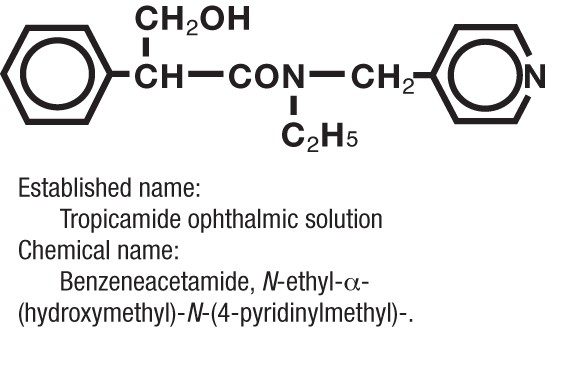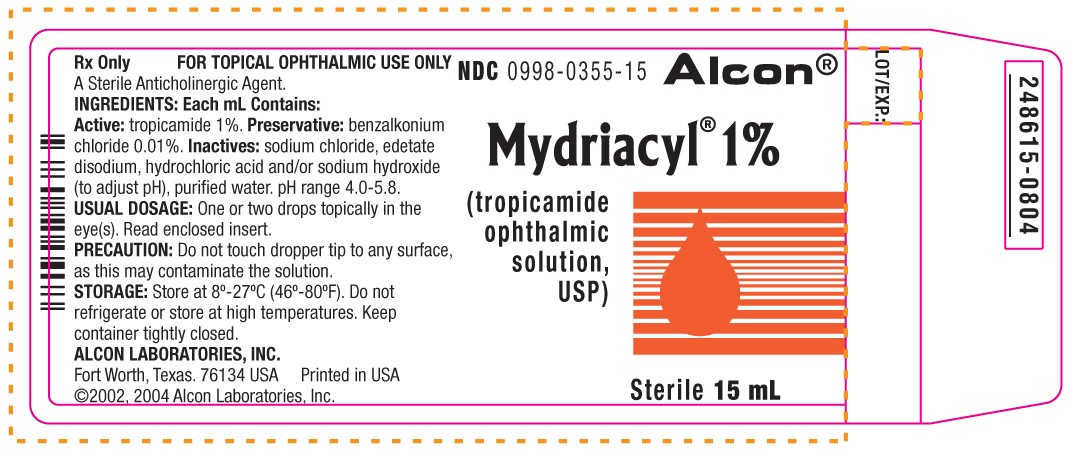Mydriacyl
Alcon Laboratories, Inc.
Alcon Laboratories, Inc.
FULL PRESCRIBING INFORMATION: CONTENTS*
- MYDRIACYL DESCRIPTION
- CLINICAL PHARMACOLOGY
- MYDRIACYL INDICATIONS AND USAGE
- MYDRIACYL CONTRAINDICATIONS
- WARNINGS
- PRECAUTIONS
- MYDRIACYL ADVERSE REACTIONS
- MYDRIACYL DOSAGE AND ADMINISTRATION
- HOW SUPPLIED
- PRINCIPAL DISPLAY PANEL
FULL PRESCRIBING INFORMATION
DESCRIPTION
MYDRIACYL® (tropicamide ophthalmic solution, USP) is an anticholinergic prepared as a sterile topical ophthalmic solution in two strengths. The active ingredient is represented by the chemical structure:

Each mL contains: Active: tropicamide 0.5% or 1%. Preservative: benzalkonium chloride 0.01%. Inactives: sodium chloride, edetate disodium, hydrochloric acid and/or sodium hydroxide (to adjust pH), purified water. pH range 4.0 - 5.8.
CLINICAL PHARMACOLOGY
This anticholinergic preparation blocks the responses of the sphincter muscle of the iris and the ciliary muscle to cholinergic stimulation, dilating the pupil (mydriasis). The stronger preparation (1%) also paralyzes accommodation. This preparation acts in 15-30 minutes, and the duration of activity is approximately 3-8 hours. Complete recovery from mydriasis in some individuals may require 24 hours. The weaker strength may be useful in producing mydriasis with only slight cycloplegia. Heavily pigmented irides may require more doses than lightly pigmented irides.
INDICATIONS AND USAGE
For mydriasis and cycloplegia for diagnostic procedures.
CONTRAINDICATIONS
Contraindicated in persons showing hypersensitivity to any component of this preparation.
WARNINGS
FOR TOPICAL OPHTHALMIC USE ONLY. NOT FOR INJECTION.
This preparation may cause CNS disturbances which may be dangerous in pediatric patients. The possibility of psychotic reactions and behavioral disturbances due to hypersensitivity to anticholinergic drugs should be considered.
Mydriatics may produce a transient elevation of intraocular pressure.
Remove contact lenses before using.
PRECAUTIONS
General
The lacrimal sac should be compressed by digital pressure for two to three minutes after instillation to reduce excessive systemic absorption.
Information for Patients
Do not touch dropper tip to any surface, as this may contaminate the solution. Patient should be advised not to drive or engage in potentially hazardous activities while pupils are dilated. Patient may experience sensitivity to light and should protect eyes in bright illumination during dilation. Parents should be warned not to get this preparation in their child's mouth and to wash their own hands and the child's hands following administration.
Drug Interactions
Tropicamide may interfere with the antihypertensive action of carbachol, pilocarpine, or ophthalmic cholinesterase inhibitors.
Carcinogenesis, Mutagenesis, Impairment of Fertility
There have been no long-term studies done using tropicamide in animals to evaluate carcinogenic potential.
Pregnancy
Pregnancy Category C. Animal reproduction studies have not been conducted with tropicamide. It is also not known whether tropicamide can cause fetal harm when administered to a pregnant woman or can affect reproduction capacity. Tropicamide should be given to a pregnant woman only if clearly needed.
Nursing Mothers
It is not known whether this drug is excreted in human milk. Because many drugs are excreted in human milk, caution should be exercised when tropicamide is administered to a nursing woman.
Pediatric Use
Tropicamide may rarely cause CNS disturbances which may be dangerous in pediatric patients. Psychotic reactions, behavioral disturbances, and vasomotor or cardiorespiratory collapse in children have been reported with the use of anticholinergic drugs (See WARNINGS ). Keep this and all medications out of the reach of children.
Geriatric Use
No overall differences in safety or effectiveness have been observed between elderly and younger patients.
ADVERSE REACTIONS
Ocular: Transient stinging, blurred vision, photophobia and superficial punctuate keratitis have been reported with the use of tropicamide. Increased intraocular pressure has been reported following the use of mydriatics.
Non-Ocular: Dryness of the mouth, tachycardia, headache, allergic reactions, nausea, vomiting, pallor, central nervous system disturbances and muscle rigidity have been reported with the use of tropicamide. Psychotic reactions, behavioral disturbances, and vasomotor or cardiorespiratory collapse in children have been reported with the use of anticholinergic drugs.
DOSAGE AND ADMINISTRATION
For refraction, instill one or two drops of 1% solution in the eye(s), repeated in five minutes. If patient is not seen within 20 to 30 minutes, an additional drop may be instilled to prolong mydriatic effect. For examination of fundus, instill one or two drops of 0.5% solution 15 or 20 minutes prior to examination. Individuals with heavily pigmented irides may require higher strength or more doses. Mydriasis will reverse spontaneously with time, typically in 4 to 8 hours. However, in some cases, complete recovery may take up to 24 hours.
HOW SUPPLIED
3 mL and 15 mL in plastic DROP-TAINER® dispensers.
0.5% - 15 mL: NDC 0998-0354-15
1% - 3 mL: NDC 0065-0355-03
15 mL: NDC 0998-0355-15
STORAGE: Store at 8°-27°C (46°-80°F). Do not refrigerate or store at high temperatures. Keep container tightly closed.
Rx Only
©2004 Alcon, Inc.
249036-0204
Revision: February 2004
ALCON LABORATORIES, INC.
Fort Worth, Texas 76134 USA
Printed in USA
PRINCIPAL DISPLAY PANEL
NDC 0998-0354-15
Alcon®
Mydriacyl®
0.5%
(Tropicamide
Ophthalmic
Solution, USP)
15 mL Sterile


Mydriacyltropicamide SOLUTION
| ||||||||||||||||||||||||||||||||||||||||||||||||||||||||||||||||||